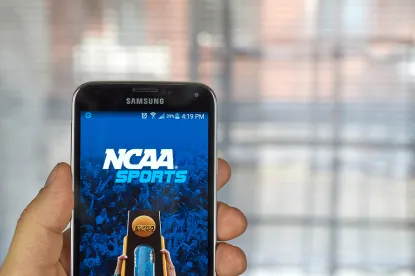The NCAA has implemented a blockbuster temporary policy allowing college athletes to be paid for the use of their name, image, and likeness (NIL). This reversal of the NCAA’s long-standing ban against compensation to college athletes opens up new opportunities for businesses to license and monetize the image and brand of college athletes.
The NCAA’s paradigm shift was precipitated primarily by two significant changes to the legal and legislative landscape. Recently, the Supreme Court affirmed a ruling in NCAA v. Alston that prohibited the NCAA from enforcing certain rules limiting education-related benefits available to student-athletes.1 In a strongly-worded concurrence, Justice Kavanaugh agreed that the NCAA violated antitrust laws regarding education-related benefits and issued a stern warning to the NCAA that many of its prohibitions on athlete compensation “would be flatly illegal in almost any other industry in America.”2
The legislative landscape has also evolved, as seven states recently adopted NIL laws, joining the growing minority of states that have already passed NIL legislation. The NCAA’s interim policy will remain effective until federal legislation is adopted or the NCAA develops permanent rules of its own. In the meantime, college athletes and businesses should familiarize themselves with the laws of their state and closely monitor how the NCAA implements the new policy.
The right of publicity is generally defined as the right of a person to control the commercial exploitation of their identity, including their name, image, and likeness. The existence and scope of a right of publicity depends on the state. Subject to state law, athletes will now have an abundance of opportunities to profit from their image: photographs, autograph signings, video game appearances, personal appearances, endorsements, and more are poised to take off. While the NCAA hopes that the policy change will still preserve its commitment against pay-for-play and improper recruiting inducements, it is likely that the most successful programs will attract the most lucrative opportunities.
However, commercializing and protecting publicity rights can be perilous. For example, celebrities have been sued for copyright infringement after re-publishing photographs of themselves on social media. While it may seem unfair to the subject of the photograph, the rights to such photos are usually retained by the photographer who took them. Still, photographs are just the beginning for many student athletes, many of whom have already taken advantage of the new commercial opportunities.
Carefully crafted licensing, consent, and use agreements will be central to navigating the new legal landscape surrounding college athletes. Businesses and students alike should seek legal advice in negotiating and drafting agreements that protect the interests of both parties while navigating the frequently conflicting state laws that govern the student’s right to publicity.
1. Nat'l Collegiate Athletic Ass'n v. Alston, 141 S. Ct. 2141 (2021).
2. Id. at 2167 (Kavanaugh, J., concurring).





 />i
/>i

